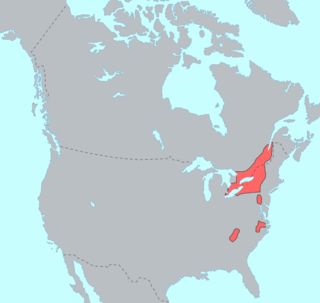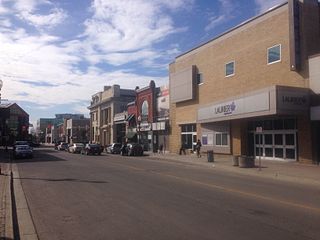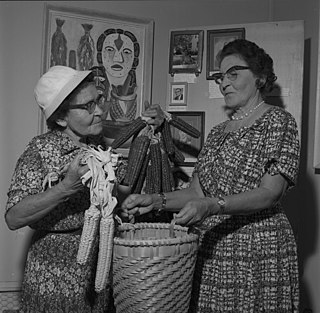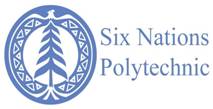
The Bay of Quinte is a long, narrow bay shaped like the letter "Z" on the northern shore of Lake Ontario in the province of Ontario, Canada. It is just west of the head of the Saint Lawrence River that drains the Great Lakes into the Gulf of Saint Lawrence. It is located about 200 kilometres (120 mi) east of Toronto and 350 kilometres (220 mi) west of Montreal.

Brantford is a city in Ontario, Canada, founded on the Grand River in Southwestern Ontario. It is surrounded by Brant County, but is politically separate with a municipal government of its own that is fully independent of the county's municipal government.

Six Nations is demographically the largest First Nations reserve in Canada. As of the end of 2017, it has a total of 27,276 members, 12,848 of whom live on the reserve. These nations are the Mohawk, Cayuga, Onondaga, Oneida, Seneca and Tuscarora. Some Lenape live in the territory as well.

The Cayuga are one of the five original constituents of the Haudenosaunee (Iroquois), a confederacy of Native Americans in New York. The Cayuga homeland lies in the Finger Lakes region along Cayuga Lake, between their league neighbors, the Onondaga to the east and the Seneca to the west. Today, Cayuga people belong to the Six Nations of the Grand River First Nation in Ontario, and the federally recognized Cayuga Nation of New York and the Seneca-Cayuga Tribe of Oklahoma.

Seneca College of Applied Arts and Technology, branded as Seneca Polytechnic since 2023, is a multi-campus public college in the Greater Toronto Area and Peterborough, Ontario, Canada. It offers full-time and part-time programs at the baccalaureate, diploma, certificate, and graduate levels attended primarily by international students, from whom it draws 80 per cent of its tuition revenue. Seneca Polytechnic has Canada's largest enrolment of international students, with 9,318 enrolled in 2020-2021.

The Iroquoian languages are a language family of indigenous peoples of North America. They are known for their general lack of labial consonants. The Iroquoian languages are polysynthetic and head-marking.

Cayuga is a Northern Iroquoian language of the Iroquois Proper subfamily, and is spoken on Six Nations of the Grand River First Nation, Ontario, by around 240 Cayuga people, and on the Cattaraugus Reservation, New York, by fewer than 10.
Gaylord Powless (1946–2001) was a Haudenosaunee lacrosse player from the Six Nations of the Grand River First Nation Indian reserve near Brantford, Ontario. His father Ross was also a highly regarded player. In 2017, Powless was awarded the Order of Sport, marking induction into Canada's Sports Hall of Fame.
Ohsweken is a dispersed rural community located within the Six Nations of the Grand River, in the County of Brant, Ontario, Canada. Approximately 300 of the 2,700 homes on the reserve are in Ohsweken, and it is the site of the reserve governmental and administrative offices.

CKRZ-FM is a radio station in Ohsweken, Ontario. Owned by the Southern Onkwehon:we Nishinabec Indigenous Communications Society (SONICS), the station airs a community radio format for the region's Six Nations and Mississauga First Nations.

FNTI is an Indigenous-owned and -governed post-secondary institute located in Tyendinaga Mohawk Territory in Ontario. The institute puts on programming rooted in Indigegogy and Indigenous ways of knowing.

Laurier Brantford is Wilfrid Laurier University's second campus located in Brantford, Ontario. The first and original campus of Wilfrid Laurier University is located in Waterloo, Ontario. Laurier follows a 'multicampus' structure, as it is one university with multiple campuses.
Education in Ontario comprises public and private primary schools, secondary schools and post-secondary institutions. Publicly funded elementary and secondary schools are administered by the Ontario Ministry of Education, while colleges and universities are administered by the Ontario Ministry of Training, Colleges and Universities. The current respective Ministers for each are Stephen Lecce and Ross Romano. The province's public education system is primarily funded by the Government of Ontario, with education in Canada falling almost entirely under provincial jurisdiction. There is no federal government department or agency involved in the formation or analysis of policy regarding education for most Canadians. Schools for Indigenous people in Canada with Indian status are the only schools that are funded federally, and although the schools receive more money per individual student than certain provinces, the amount also includes the operation and maintenance of school facilities, instructional services, students supports and staff. Most provincial allocations per students do not include the maintenance and operation of buildings, as most provincial governments offer additional grants.
Cumberland College is a regional college based in Melfort, Nipawin and Tisdale, Saskatchewan that provides post-secondary education in the north east region of the province.

Anishinabek Educational Institute (AEI) is an First Nation-owned and controlled post-secondary institution in Canada. Indigenous institutes partner with colleges and universities to offer students degree programs, apprenticeships, certificate programs and diploma programs. AEI was founded to provide greater access to post-secondary education for First Nation peoples. AEI delivers post-secondary programs approved by the Ministry of Training, Colleges and Universities. The educational curriculum was adapted to meet the needs of Indigenous learners to ensure it reflects community needs, cultural heritage and identity.

Seven Generations Education Institute is an Aboriginal-owned and controlled post-secondary institution, co-founded by the ten bands in the Rainy Lake Tribal area in 1985. The ten bands are: Big Grassy, Big Island, Couchiching, Lac La Croix, Naicatchewenin, Nigigoonsiminikaaning, Ojibways of Onigaming, Rainy River, Seine River and Mitaanjigamiing. Each of the bands appointed one member to the board of directors of Seven Generations Education Institute, which functions with the leadership of the Executive Director.

Iohahi:io Akwesasne Education & Training Institute is an Aboriginal-owned and controlled post-secondary institution for the Mohawks of Akwesasne.
Charlotte Edith Anderson Monture, known simply as Edith Monture, was a Mohawk WWI veteran, known as the first Indigenous-Canadian woman to become a registered nurse, as well as to gain the right to vote in a Canadian federal election. She was the first Indigenous woman from Canada to serve in the United States military.
Rebecca Jamieson is a Canadian Tuscarora educator and education administrator. Since the late 1970s she has worked to improve access to education on Six Nations of the Grand River, the most-populous First Nations reserve in Canada. Jamieson helped to found Six Nations Polytechnic (SNP), an indigenous educational institution, and has been its president and CEO since 2009.

Julia L. Jamieson (1889–1975) was a member of the Six Nations of the Grand River in Canada.















